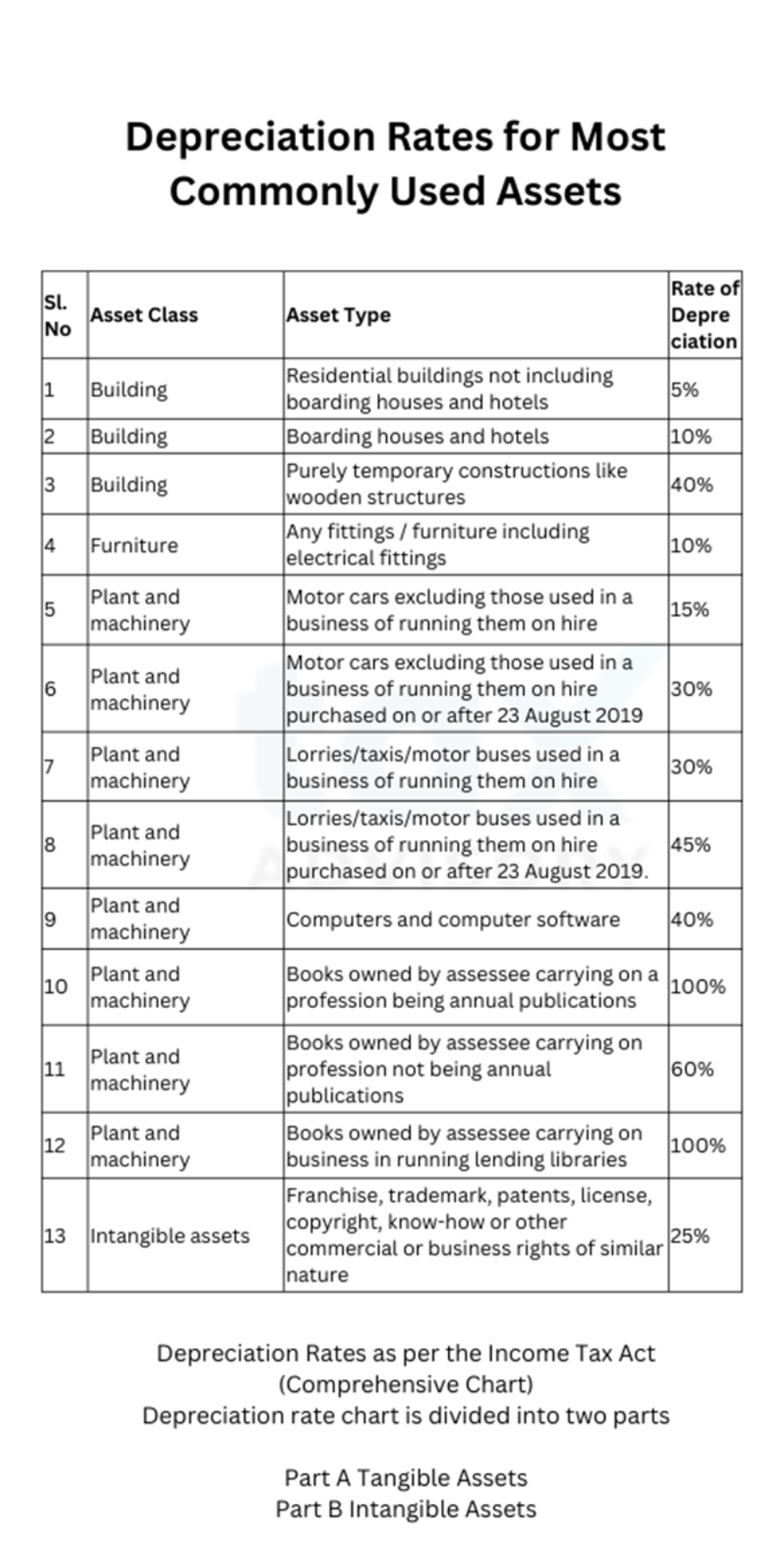Depreciation Rate On Assets As Per Income Tax
Depreciation is the decline in the worth of an asset as it gets older or is used over time. When individuals or businesses calculate their earnings and profits from their work or business endeavors, they are permitted to request a deduction for this decrease in value on assets they have bought and utilized for their work or business. Every Businesses and professionals are required to figure out how much their assets decrease in value over time. This is mandated by the Income Tax Act of 1962, which provides specific rates for how fast different types of assets lose their value. Here in this article we will cover depreciation rate as per income tax act for ay 2023-24 & 2024-2025.
What is the Block Of Assets Concept?
The concept of "Block of Assets" refers to grouping similar assets to calculate depreciation under tax laws. Instead of treating each asset individually, assets are grouped into blocks based on their nature, type, or usage. This simplifies the depreciation calculation process and allows for easier administration and compliance. It is figured out based on the Written Down Value (WDV) of a group of assets known as a "Block of assets."
These blocks include various types of assets like-
- Buildings,
- Machinery,
- Plants,
- Furniture
Intangible assets like-
- Patents,
- Copyrights,
- Trademarks.
These assets are grouped based on factors such as their lifespan, nature, and how they are used. Each group has a specific depreciation rate as per income tax assigned to it. So, instead of calculating depreciation for each asset, it's done collectively for the entire block. This means that under the depreciation rate as per income tax act, assets within a block are considered together rather than separately for depreciation purposes.
What are the Conditions For Claiming Depreciation?
To claim depreciation on assets for tax purposes, you need to meet specific conditions:
- Ownership: You must either own the asset or have it on lease for a minimum period as per tax laws.
- Usage: The asset must be used for business or professional purposes. Assets used personally aren't eligible.
- Active Use: Depreciation is only for assets actively used during the financial year; idle assets don't qualify.
- Asset Categories: Assets must fit categories outlined in the Income Tax Act. They're grouped as tangible (like buildings, and machinery) or intangible (like patents, and copyrights).
- Block of Assets: Depreciation is calculated for a group of assets, not individually. Assets with the same depreciation rate are grouped.
- Written Down Value (WDV): Depreciation is based on the Written Down Value (WDV), considering the asset's actual cost and previous depreciation.
- Compliance: Following documentation and reporting rules set by tax authorities is
By meeting these conditions, you can rightfully claim depreciation while adhering to Indian tax regulations.
Methods of Calculating Depreciation
There are two common methods used to figure out how much an asset's value decreases over time: the Straight Line Method (SLM) and the Written Down Value (WDV) Method.
Explaining each one with an example:
Straight Line Method (SLM):
With SLM, the asset's value decreases evenly over its useful life.
Example:
A company buys machinery for Rs. 1,00,000. It's expected to last 10 years and has a value of Rs. 10,000 at the end.
Depreciation per year = (1,00,000 - 10,000) / 10
= Rs. 9,000 per year
So, the company can claim Rs. 9,000 as depreciation expense every year for this machinery under SLM.
Written Down Value (WDV) Method:
WDV lets the company claim more depreciation in the early years, tapering off over time.
Example:
Now, consider the same machinery. After a year, its value decreases to Rs. 90,000 (with Rs. 10,000 depreciation claimed already). With a depreciation rate of 10%, the calculation is:
Depreciation per year = Rs. 90,000 × 10%
= Rs. 9,000 per year
Again, the company can claim Rs. 9,000 as depreciation expense for this machinery under WDV.
These examples show how businesses calculate depreciation using the above methods, giving them flexibility in managing assets and taxes.
Depreciation Rates for Most Commonly Used Assets
Below you can find the list of Assets depreciation like depreciation rate on car as per income tax, depreciation rate on software as per income tax, plant and machinery depreciation rate as per income tax act, printer depreciation rate as per income tax act, and office equipment depreciation rate as per income tax act-
Final words
Depreciation rates as per the Income Tax Act determine how much businesses can deduct from their taxable income for the wear and tear of their assets. These rates may vary depending on the type of asset, such as buildings, machinery, or intangible assets like patents. By understanding and applying the appropriate depreciation rates, businesses can effectively manage their tax liabilities while accurately reflecting the decrease in value of their assets over time. Want to know more? Get in touch with us now!!

.png)

.jpg)
.jpg)
.jpg)

